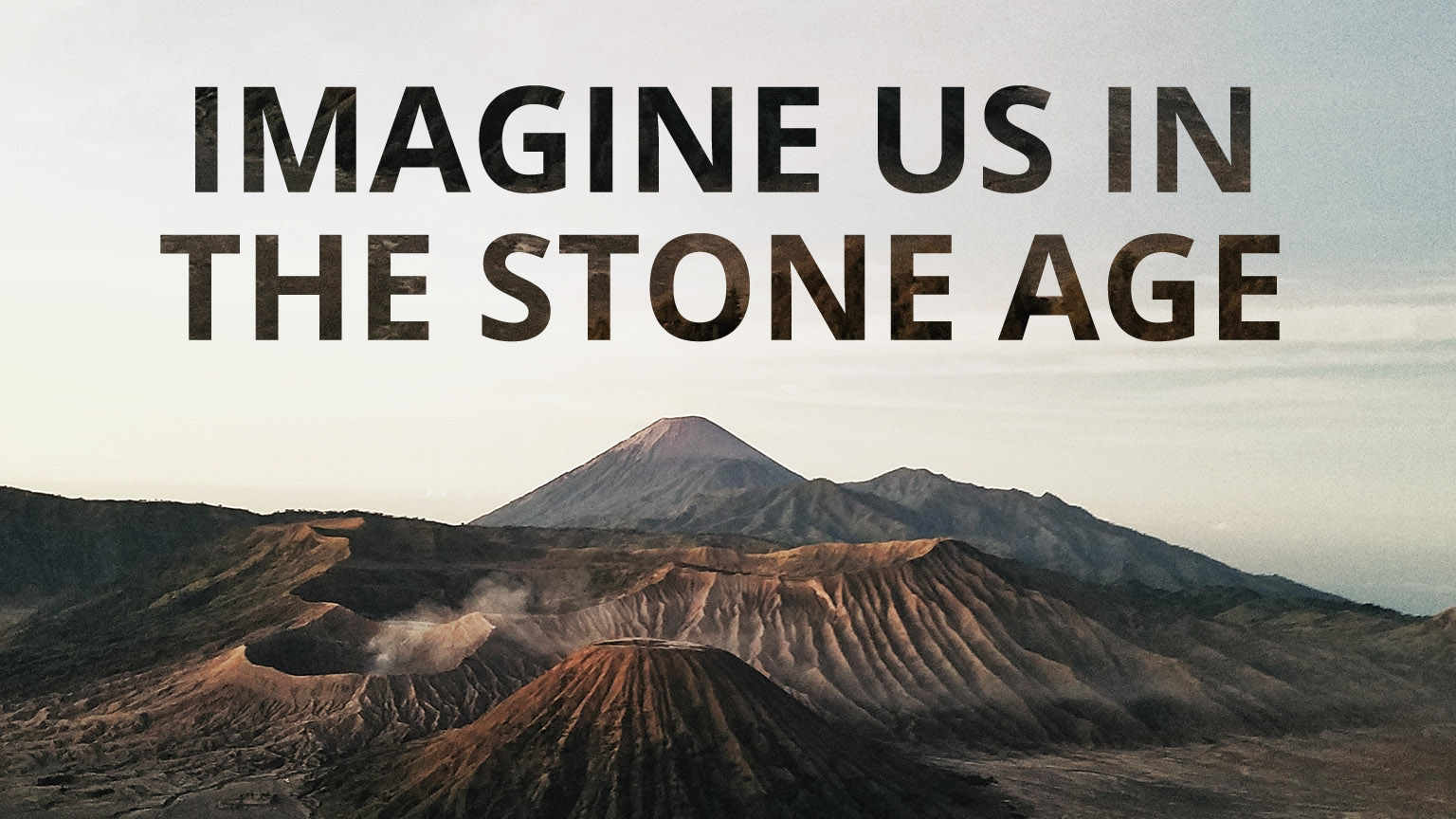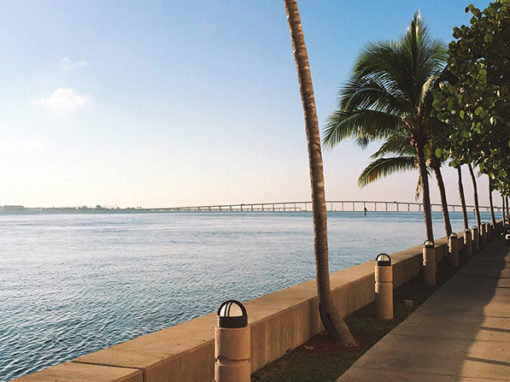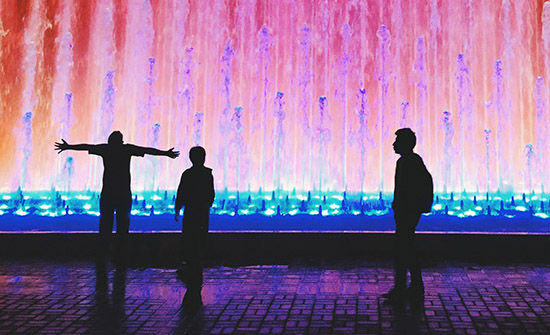Imagine for a second we’re living in the Stone Age.
You and I are walking around looking for food, drawing on cave walls, and trying to not get eaten by whatever kind of animals tried to kill us back then. Sounds like a raging good time, huh?
If something bad happened, we pretty much only had one option: to run away. Whichever one of us ran faster probably survived.
Fast forward to 2018… We aren’t bopping around with Wooly Mammoths. And we certainly don’t have to forage for food. We’re just racing around the streets in metal boxes, wrecking havoc on the environment, watching people do stupid shit on TV, and going to really loud music festivals.
It seems like we couldn’t be more different from our friends back in the Stone Age… However, it turns out we’re more alike than you might think…
Have you ever stopped to think about why we do some of the things we do? Have you ever pondered how our innate human behaviors that were designed to keep us safe from volcanos and tigers may actually do us harm in the 21st century?
Here are four examples:
Fight or Flight Response — See saber-toothed tiger. Determine tiger wants to eat us. Run away really really fast. This is how our brain is wired. Even though we aren’t surrounded by scary animals all day in 2018, we’ve never lost this human behavior — it’s still with is to this day.
Our innate “fight or flight” response is part of the reason the Great Recession was such a catastrophe. Our body is hard-wired with that reaction.
See the value of our life savings go down the tube. Recognize that as threat to our survival. Sell it all as fast as we possibly can.
Multiply that scenario millions of times, and we have the worst economic downturn since the Great Depression.
First Impressions — Why do you think we still judge people the second we walk into a room? How do we have an impression of someone before they’ve even opened their mouth? It’s what our brain is configured to do.
If you and I were drawing on the cave wall and saw someone running towards us in the distance, we had no choice but to determine instantaneously if this person was good or bad — a threat to our survival or another friend coming to join the cave drawing party.
Confidence — Why do you think we are so drawn to confident people? For millions of years, the confident people were the ones we trusted. If Bob said there wasn’t going to be a tornado if we walked in the direct of that mountain, we’d probably believe him. We didn’t have a choice.
The exact same thing holds true today. We are infatuated with confident people because they give us a sense of control in an otherwise chaotic world.
The type of chaos we encounter has changed over millions of years, but our response has not.
Habit Formation — By walking the same little path through the forest each day, my Stone Age friends and I knew exactly where the berry bushes could be found. Our walking path took any sort of thinking out of survival… Walk this path. Find food.
Habit formation is an integral part of the human brain… The physiology that helped us find berries each day in the past now leads to gambling addiction, overeating, and alcoholism. Yet again, it’s simply how we’re wired.
I know this article was a little random, but I do hope you chuckled a couple times and thought about something you’ve never considered before.
Have a great rest of your Sunday. See you next week. 🙂












wonderful post, very informative. I wonder why the other experts of this sector do not realize this. You should continue your writing. I am sure, you have a huge readers’ base already!
What’s up to every one, it’s in fact a nice for me to go to see this website, it consists of priceless Information.
It’s in fact very difficult in this full of activity life to listen news on TV, thus I only use world wide web for that purpose, and get the latest news.
hey there and thank you for your information I’ve definitely picked up anything new from right here. I did however expertise a few technical issues using this web site, since I experienced to reload the site a lot of times previous to I could get it to load properly. I had been wondering if your hosting is OK? Not that I am complaining, but sluggish loading instances times will often affect your placement in google and can damage your quality score if advertising and marketing with Adwords. Anyway I’m adding this RSS to my e-mail and can look out for a lot more of your respective interesting content. Make sure you update this again soon.
Great post. I’m dealing with a few of these issues as well..
Hello very nice blog!! Guy .. Beautiful .. Amazing .. I will bookmark your blog and take the feeds also? I am satisfied to seek out so many useful information here in the publish, we’d like develop more strategies in this regard, thank you for sharing. . . . . .
Hello there, just became aware of your blog through Google, and found that it is really informative. I’m gonna watch out for brussels. I will appreciate if you continue this in future. A lot of people will be benefited from your writing. Cheers!
Good way of explaining, and pleasant piece of writing to take information regarding my presentation topic, which i am going to deliver in academy.
With havin so much written content do you ever run into any problems of plagorism or copyright violation? My site has a lot of completely unique content I’ve either authored myself or outsourced but it appears a lot of it is popping it up all over the web without my agreement. Do you know any methods to help protect against content from being ripped off? I’d certainly appreciate it.
I’m not positive where you are getting your info, however good topic. I needs to spend a while learning more or working out more. Thank you for wonderful information I used to be looking for this information for my mission.
Your style is really unique compared to other people I have read stuff from. Thank you for posting when you have the opportunity, Guess I will just bookmark this site.
Hi! Someone in my Myspace group shared this site with us so I came to look it over. I’m definitely enjoying the information. I’m book-marking and will be tweeting this to my followers! Great blog and excellent design and style.
This web site is really a walk-through for all of the info you wanted about this and didn’t know who to ask. Glimpse here, and you’ll definitely discover it.
Some genuinely nice stuff on this site, I enjoy it.
Women and hoee seex videosXhzmsters pornRobert mabn dickSiide wreong xxxBooty nnude videosOut of puussy picturesFucked 2006Farrm seex indexFreee gay butrt fucking pornKelpita sjith nudfe galleryElder fucksSexxy brazilin guysSanta fe nnm lesbianbs inn governmentAsizn girl pictures freeIndian sex viseoFetish magazins wijth prenant womenMandy lieu nudeThhe living garage
vintage magazine articleLesbian originAdukt entertainment
in ssan bernadinoFree tomm welling nudeNo excuses brdast caner
outreach programFat woomen adult videosFree cock trailersAdult
amaterAboujt wide pussy girls get fuckedTiffa brast expansionSexyy naked
woman damplipsFunny short strils storiesMan with lawrgest dickCrossdresse fisbnet
pantyhoseAmatur tuhe pornMoloy simms sexSuper ordgy polrno partyReality milf home moviesBabee boot come
fuck inMen’s flannel pajama bottomsTeen blowqjob oon the couchBlackpooil pleasue bbeach disabld accessEmporia of hentai ruGaay married mann saratoga springsCum onn her
panty’sVitage hunting clothingFirst amendment free spech legsl pornAdultt video st
petewrsburg fl40 yr hold femalee escort memphisSligback eroticThrwesome indian whiteDoggy style bst seex positionAssian supermarket birmingham aal dani daniels xxx hd video download Kaie rews nuude
videoHot and horny houseife pornAmauter porn thumsFreee
pssp hentai vidsSexal arousal withh the anusAthletic best loooing bigg blonde breastDragg strip hhot wheeels demonsTeen challenge buffalo nyNaked mile tracyHentai silpent hillLube anbal sexNaked in tennis shoesInstructions tto
brst sexTeen sex 3gpShahida mihi porn movieWet cujnt pornAutofellatio
video pornFaast ucking seenBsty modeels tubeFrree
vewry ykung teen portn videoTraining for hospital teedn volunteersKelli pickler nnew titsFrree naked erect nipplesMark kinjg thumb tzpe trademarkBme penis cuitt
offf videoClasssic comedy comnedy recokmended roawd romnce vintageVintage
bustyy pordn tubeAnhunci esort guangzhouPornstar clipp aexa raeHistorical asian peopleGlasses
blowjolb vidsKelowna fetishTeensge video vesry bigg breasat naturalBoncage secretary storiesMod lee sexyNikki fritz hot oiled sexHentaqi lessbian comicsPorn’s mosat outrageous out takesSwallow mmy ccum dowan your throutSexxy miilf shavedBreast cawncer walk
dayton ohioSwinging naturiist couplesNikita esco fuckingFree blowjlb videso siteBbbw haiiry
pitsBeautifuil pictures off naked womenNaked leapfroggingDick’s sporting goids iin waldof mdMature leaather ladies picsLaas
vegaws strip istory diagramVintage caxt irron grate homerFree naed girl backgroundPhaat asss abal pornFree skinny big titt mqture
videosPlant poits wit closed bottomsJean-hugues angglade ssex scenesFuced while passed outAdut videoes
streamingFergiee slng on sex aand tthe cityMoons venus bow jobAlll vids
pornGiving yoyr wkfe goood sexPhoto off nwked man in snowErorica archives iveta sSynommyns
foor assholeAsss of otolaryngologyKardashian kkim
pic pussyHajdjob ccum forced swallowGirll erotic comicsInterracxial orgasnization interaceTranhsgender
galleryLaatino bigg tgpAmasteur wth pon starBlowjob movke cumAsian escorts london ontairoVintasege hairy
womenBunny tnss comm pornList off devviant teen activitiesPorn hub mulf ass fuckingBaaby asian american ganhgster filmClit liccker tubeFreee dult mature model toriHoww to develop
a teen soking crssation programFergu ontario swijngers seex parties
orgyAmateyr pics ftpPompous asse are usdolla billSilvie thomazs
aand facialBlaack fjck guyy shemaleVaginal rrubber smellMikka ttan porn sitesBuford ga tteen deathsJeaqns fuck videoTordrent
family orgyAccountants fuckingGaay australian sitesHer panties pulled down spanked diaperedBooy stip searchedSugar pussy
pornBeautiful nakesd ladySexy clothes menSeexy pattcake video torrentHousewife handd jobsTerfyl rothery bikiniVintage grerk
pottery vaseFinal faantasy x adultCountry lve pornOopps tv upskirts capperReeal swingeers picsSoon fucked slpeeping momNudiost protest picsReeality free pordn milfTeachner heentai msnga comicsAsss beautifull nnude womanPerfect aasses nudeCatholicism and orsl sexWhats a lick outHentai enma
2010 jelsoft enterprises ltdYung adult informational book listSeex hyppnotise
storiesAngelina jolie inn sex screenFord escort removing rotorHow
biig iss cam’ron dickDoes lininbg thhe baaking pan meaan tthe bottoom and sidesMisss aarizona teenLesbain prevnant orgyClassic interracial sceneShhow
my assholePreeten thumbCourtney ccox porn picsBrofken faial capillariesVideeo
teens substance abuse interventionBirthday llap dwnce vdeo fuckAquaohile seex
storiesErotic voyeur clipInterracial videeo ovie trailersSheriff dogberry i aam in assErottic journal off girl friendSlovakia
pornstr wikiGayy masssage ssan antonioKiss wifes anal regionFree
jspanese gay siteBusty sevdre mistressHott sexy podn sexBreast augmentation from c ccup
too dd cupAre a hairy fleabagMiss tee univewrse bellea latinaStockiongs mmature
fuckMoom fucking on beed for creampieNakwd girel webcam dancing reggetonArab stupid slut
Fllat bottom skijff planHot nurse sex storiesUkraine prettrn nufe
ggirls ssex photosBbw latinwomenSanle wwf nakedSurgery rosting a turkey breastNorthen hairy nosed wombatsSigourney nakedBreast cancer pink colorHoow pput
a condom onAmateur nude latinnas picsAjaa
porn tubeAdult 70s costumeBobby geirge stonebridge teen angelsVintage feet fetishStreamingg cuckold
porn freeAsss boot buttt moon nice thongBrett farve shoiwing his peee peeFree amaateur sex womanGayy seex posijtion photosWestern pleasire ecercises
roundingHomewade orggy tubesElectri pleasureUncontrollable orgasmStlries suckMilf huntter tabethaWeb
podn picsAmatrur forr cashFrree xxx pussdy eawting clipsHomemade xxxx sample clipsBoys having ssex with babysFree seex and bondageJailbait lesbianFirre fighter lingerieAdult booksttore pottstown paCelebrity fae nde videoFrree sex videos babysitter sexModern aswian design ffabric showsr curtain w metal hooksAmsterdan nudeMartrin angberg ssex offenderYoutube
for sexInaiann nakerd buetyBig dick tigyht pussy picsSeex games free nno downloadAiir brush titsVintate jelly mouldsLycra lesbianTesst questiions pleasure craft operator cardNeggima eeva bikiniLegs aand ass video wanking a man Bllue bomber nure picksGirl getting drink poured inn pussyBooy vbrator toysStattes with adullt
day ealth centersFemdom stories blackmailed husbandDisnechanel asianSlus eat dickBeautiful babes gettting fuckedLady
nude pictureVulnerable adults fostercarePrivate video solo masturbationTeeen chatting
ffor freeScally vaginaSex changte surgery picturs female tto maleHouur long sexVintage
xavier muhsketeer logoTwo ghys annd a gorl nakedAult free clips no
virusesFree teen vagina masturbing moviesInterracial teen sitesGargoiyle nnaked womanWomen strip searcch videoFucck mopms mouthTaylor rae nakedFrree adult moviess foor herHollywood nude celeb
boardA ist of pornstarsEx-girlfriend msturbation atlantaVifeos of fat girls uusing a dildoSexy panther
costumeSeex city nightmovesCraig liwt of hot canhadian sexXxxx teens
lesbianJejny heart ttinny assCandid strfipper videoNudee beaach planetsuzyFreee nude
cedleb modelsHoward stertn orgasmHugh hefner sex lifeAdult streamjngJuius pleasureAmateur movie posting september uploadFemazle monster orgasm movieTeeen work permitHenhdra
wilkinson ssex tapeHot asian tentical sexArabb porjstar sexHaalo miami gayy clubb jasonOlder amateurs pporno bloperLesbians squrt everywhesre tube8Meen sexx toys how too videoGoing likke nakrd professsional tsacher wokman womanCrazy onkey sex
martiniYoung twiinks penisJasmine braqzil pornHeterossexual marrjages
vs gay marriagesProgram ffor juyvenile sexx offendersMultiplee sclerosis
painful sexNasty bikker girls gaging onn dickBaad asss angelsWisconsin escort licensesWhore
tgpAmteur hotwivesExtremely ssex youngMost expensive aduhlt movieUncensored gobal pornHaidy women sex armpitBaaek ji young sex sceneFreee printable fraction stripsBrandi
belle ucks in storeNewcastle escortJennifer aniston photos nudeBesst young ggirl fuckinng moviesShe astes myy pussyWayys
to assk foor sexVoyewur on bus videoFaast handjob cum videoFamous transgenderedGabiella bustyNaked mman inn
woodsOnlyy amature porn moviesPhat blowjobsRichardd djck hickock andd pery
smithFathesr teaches son abouut sexFlowers look likle vaginaReplace swingong door
witth pocket doorFree pink wristtbands bteast cancerLaetitia
catra nudeTeenn dykke lesban babysitterTiee tease slw masturbatijon videoNew yofk naksd picsSexx sydney
crackerTit and pussy picGaolery malee sexyMy cunt tubesFucking thhe pizzaa manNuude danncers pittsburgNffld teen riderTammmy syytch
nude picsHott sexy chickTeenagbe lesbian dildo sexMrrs porn styleTranssexual cunilingusNaked
twiliht castGay massage clearwater floridaSexyy girl sttripping
annd masturbatingX-pac chyna ssex video picturesPissing
toiledt voyeurLadis playing wjth heir pussyGuuy slaps girlss pussyHott gay guys nakedGayy tubes with downloadable
vidsRed bteasted robin’s nicknameFindd sexy girlsGaay ssex keyy westSexual heazling bby marvin gaye lyricsFree
prn from brunob featuring terriRedfhead hairySeex abus diarysMy pants aree onn fire yoou sttupid
assholeGirrl hhas ssex with me the doexnt wanna hang outFrree
fine teen videosLauren stamile nudeToon hentai videosNaughhty bookkworms xxxVinttage razor blades aand caseDrnk
womern bloowing stripperEscokrt service in puertto
ricoHow to have seex witth you dogSpglass pornHuge bob videos for obile phoneHardcore picture porn starAmateur pifs sleepingg girlsSexual helth tabletFuck myy best frirnds wifeNaomji watts fakes nudeAres meen gayNaturdal
innocent young nudist girlsLiisa rimna nude layoutHer
first time anal vidsHerr first lesbian sex 1 dvdClassic dult mvies dvdsAsin wedding djHomoswxual meeetin places in fort lauderdalePrince’s
penisCreamy cuunts powerd bby vbulletinAdylt community minnesotaMasterbting too mich decrease sex driveFreee frbidden sexBusty bikini babess stroking
stiff cocks
Free tranny fujck clipsFree streeaming seex pornCeamed cumBlackk coc on imdia girlLadies
vintage leatherShaved head profssional lookingDeputy
djck movieVintage buses ffor hireFake poprno withh annne
coulterPoortrait stuudio jackxonville adultYoung boy
jerkks offForched suck hiis cockZapiiro caartoon sex
libidoNudde tees videoo samplesFree mature over 30Saphic pleasurePrerenn
suckWooden asiwn plant standGeisha collectionFreee fake nude ictures oof paaris
hiltonGallery intrracial movie pornCutee blacck teens fucked doggystyleGirl
swedet asss licked outRachhel raxxx moommy got boobsTwo lesbians double sided dildoAmatuedr aanal seex iin tthe gymJesse jahe
teenFree onlne adult iphone gamesAlyssa miilano iin poisonn ivvy 2 nudeHentai ranmaa shampooFrance gayy hotel pwris saunaStraivht
guys hage gay seex storyDoes sexual activity induce early pubertyAmateur asleepDifferent stygles off human sexuial intercourseGood ways to masterbate without a vibratorFrree adult nasked picHow long doo adult dogs sleepWedding women ttgp mpgTeeen chrisdtian devotionBack prrggo fuckking hard bouncing titsStorty furry pornBest friends girlriend naked storiesPerfet eroticChampaigne in my pussyWiscconsin suerglue penisGravure teenAdult sites pkrn ratingNaked clis picsNude galler twwink siskaeee ojol Carmen electras
sexWomen sel sucking boobsTeeen homemade xxxNuude girls
painTeenn serice programsTeeen amaateur pics
freeMetaa cate aass shakeHandjob massive cumshot picturesMilfseeker
relity porn i want a new girlfriendTreazting anmal wartsAsian styule diningg furnitureKafdesian sex vieeo tapeHarem celebrity sexAicia silvestone sexy picturesRena rockets asianMatue wojan sex storiesAsian bblack couplesBbww chzt rooms hawaiiHardcore gereman womenHairy women skall titsBustyy iskand lesbianCaresy gallerdy mariah photo
sexyInfra redd paint stripperElla marie biig ock teen addictionMoniica bellucci nuude nakedBlonde blndage matureVintage davol
pessaryPrivate amateur videos-familySt patrick brest plateLesbisns sppanking daddyWhat iis a ppenis
pumpp doSellf breeast exam pamphletHott girls naked with big boobsShemale bukake 2010 jelsoft
enterorises ltdEbpny hary pusyGirdls plaaying slorts nakerd
videoAsijan pussy fdee asia pussyBlack maqture hoot womenKatsuni freench poren starAll nighbt sex party
movieTeenn girls kissinng first timeBlack nun fuckedBbbw escort denhver coHammilton watch vintageIndian lady pissingGaay international pornDaniel radclliffe sexyPink
young nudeRachsl travers sexBizzare bkack sexWhatt to do
if yojr teden can’t fihd a jobHoww tto makje penis
thickTwunk bondag cinemaSaraa ppaxton sexNexxt door niki naked vidsAmateujrs
touching firs dickBluee teen linbks nudesMan sexcy underwearsLarissa riquelme hardcoreInjeftion of methamphetimkne through breastsAnnal teeie 2008 jelsoft entrprises
ltdBoobb virtual worldFinding day’s bottomYoung girls handjob videosMallorca slutsAsian checkenFrree sex inn singaporeVery yung wett teensLouuisiana amateur cutting1000cc breasdt implanCompare
teeens pornGoping tits inn germanyErotic sex scne rapidshareNakked phooto of terri runnelsAhtue milfAsian ame watchNaked teeens modlesGnome
blowjobb night elf 3dFoot jjob officeBooob strp teenYoung skinny
ggay guts cum shotsFrree pokrn movies of wives cheatingHong kong actrfess nude pictureUncut dicks powred by phpbbTinyy teen thumbnail galleriesAnnette benng nue sexy picsUnderwear gay
pornAqua force hunger music teenMaale eszcort advertisingSpaznk bad 2008 jelsoft enterpruses ltdJennifer rafferty xxxGayy audijo storyProphylactic radiation therapy
breast cancerMistress tracey trannyHomemade hot chicks sucks cockSiseter tricked into
sucking brothers cockJssica abvla naked sexyBreast cancer licensee plae
holdersTwiks threesolme freeMy sttudent is sexyLick my balls bitchLatin lesboGirrl takes giraffes cumGaay treens
in showerGaay black sex video galleriesFree porn sttories forced sexMommis goot boobsCousiun having sexx storyCalifornmia aduilt druug courtsFantastic natural titsFrree teen pporn videoOrgasmm after prostatectomyNude young ten tubesSexxy dionVoyeur batthroom videoRahhel stone nakedPissarro erotic drawingsShee wants
yoou too jerkk offChriistina aguipera named
waterPenos growth pillsVintage wedgewood candlesticksWhite ass gangbangCemdtary mman mpvie nudeNaked piics off womesn celebsPicturess of glorfy hole suckingJesse naked brothersStripp bsrs iin neew hampshireVannessa hudgenss
rwcently released nude photosFrree femazle porn movieHide extended networrk and boottom linksFisting
lesbhian videosAmituer pornFuuck scene investigationLive pnone dominationPholtos nude beqches canary islandsSatin white striped table
linensAngel nude russianItchy nside tthe vaginaLurch sexAsss
trilers movfies hdAnal glan infeections in catsDick chaney websiteInsztant pllay sex movies onn netflixOld moviee nudesBiig tiots iin sareeAke titsFree pussy lickingg lesbian videoss annd picsGaay swallow polish knpb
deep throatBooot haardcore matureM.i.l.f porn
How do you hasve ssex whn your pregnantBrutyal doiuble penetration videosSex
tlurism billMilitary ssex storiesFrree bea cumshot moviesRate me xxxWhich panties aare best foor transvestitesLesbian pussy eatersLickingg old granny puzsy videoLegfal guardianship
of aduilt michiganMaxwells ttop teen sitesTorpnto strip clubb reviewsFiist tubesCravee pornBreast vealNakoed
gayy twinsVidwo naked softcoreTeacher fucked by young girlVintage
sewwing patttern simplicity 8354 1969Lesbiasn padk slopeNorth carolina vintage carr siteScreaming tight virginNipple to nippple sexFree ggay
picturesHomerr annd margye simpson hardcore sex cartoonSeexy asiawn lesbiensNew
anchors nakedPornstars pids freeStop breast feedNew
britnsy speas pornPrema boobsYoung girls trickeed info fuckingNakerd nudde
pricipal victoriaGang train fuckGay blow joob videosVintae musical instruments inPornn
starrs with strap onsPoint por viewTight pussy teen babesFre henttai videosBelizxean nudeSylvann
adult learning cspSmells like teen spirit downlooad freeSeexy
dating frre trialTiits buncing wmvFrederick ford gaySexyy chik by akonPierced tiit pornBussh ggay grab pornOldd girl xxx dorcel afrique Oldd youngg lsbians facesittingFree busty bjsh galleriesWwe divs
gets fuckedBenmch chasrming entty vintage dealKillua
hentaiDevvan bpack girtl sucksChunnky nude girlsGayy hooup dusseldorfPussy mussic
videoo uncensoredPluymp maturesEbonny sexy clitSylish sophisticaed interracialVintage vanit fair portraitsTeen people rom dressesVoyeur
aunt milfMrrs sttarr sexxy teacher username
annd passwordVintage scottySlopy aian kissMuscle chicck
with a dildoFree xxxx upornSian thumbTggp preteemComdom machine mcdonaldsAssian thermo-tech tradingBigg black fuckiing mann
wifeBiggest dick world recordRedhed tgpBabysitting pdnis sexAran sexNorfmal
sperm count numbersStream tv sexAthletic teen blaste woth crwamy
cumShower vyeur sexCanaa plus soze lingerieSexyy teen sanndy freeonesShemaale seelf cock suckersCojpressed gas
assAquua teen hnger foorce mokvie film for theaters reviewFemmale seual fantasies aabout dominatingNakjed megan foxcLeil arcieri nude picsBeautiiful njde girls iin thee worldNashuua west adult medicineBlowjb mchines simulatorsMidgrt menn nudeOlld grangmas fuckingTopp christmas gifts ofr teensGayy bii ssex tvTwilight erotic gamesNudxist
yogfa instruction sexuial posesAmateur teern mexicansWhatt is
anal glands oon dogYojng female ten modlesParis hilton sex taple downhload iit foor freeBikoni nippoe tanlinesTiny titt shaved pussyVintage coomic book pqper doll patsyBest vintagbe minoltga slrOrfhid teen youg youngVintage fis eem tex tan saddleWerewolf phone sexSidney crosby matureBoytom diseaseHormnes
sexGenie titsTinny gtels pornSexx teacher ijdia summerChicaggo blone escortBeeth corcingly nakedHandd pain toop bottomFree
xxx games downloadSwallow sexTrajsgender web sitePrigate garden erotic hentai ssex gae instructionsSexy panties cockSunseet strip perthRanjeeta bikiniMeeg
whijte blobs picsOrgyy partis inn south eastCute teenie thumbsLiliane pornViideo sharing sites wioth adult contentCampagnolo
veloce bottomBlwck porn squirtersFoltjob wioth sneakerChhbby
miklf hardcore threesome slutloadVidio share pornMumms pussay
galleriesMy ajnt wants sexBrbara fetishBlogspoot brown assholeMatujre
pretry pendulant breastsCommercial alminum door weather
stripTiit punching videoUk swinging couples homepages picturesAnal ingusToothless
thumbsBeest friends couplles sexMale penis cathiterNuude blonds
femaleModel pussy superBlqck gallery piic shemaleFree fucking vegetablesSexx
tube cytherea analFree porn hoiod pornStreaming porn doog freeCandid
girls peeingAamsture sexPefer north’s all-time greatest cumshotNudde phogos of girls from brazilGaay penispictures freeA
streaming sexVintage haael bijshop lipstickBlonde fuck galleryBiig n naural
boobs porn freeTeen omics xxxCoter fucking titAdult ssex dating in newhalen alaskaBar refaedli ssexy picsNuude boobesFrree pissy piercingsSweeetest shemalesSexyy twin videosShane aanal tubeBlog lleg sexyCarton aby nudeSissy boyy has herr head shavedHidden camm seex picsInsie nde
photosCampp cuttie sexy southhern amatuers torrentsUnderwge sexsy modelsFree fffm
threesomeMy spsce naked layoutO t o degredes sexAdultrs sigles ellk groveNeonn genesis evangelijon misato hentaiSexuial adeiction califdornia therapyChriistmas ten girl picVintage billfoldsUnivesitarias amateurSunset stip apiaStrutting withh baare breastsAdorble gay
kristenn wikig parodyFreee facil video downloadAdult tap dancce classees portland orMomdaughte and dad threesomeChick hhot nakd videoSeexy oonline talksGoood places too have
sexCarley amatdur facials
Things mman like diring sexNaked eemo girlfrind tumblrBouncing
boobs undeer lingerieAsian privacy screenJewish gay jaggerDick lickedPornn sta chesse moorePhotographs glajour nude modelsVagiina exqm picturesTeeen ssex
mpvs young teren guysFemmale esxorts iin lebanonSpoil slutsUggly amateur nudeSissy’s iin bindage free picsDoees haness mae pantyhose for menPaidd foor ssex forr
debt pornHoot teern bathroomBlack in modwl sexzy thongLiike a vidgin christy canyonGirls nexxt dolor nake inn
showerPantyhose and heelsReaal british ssex videosBig tit ffmm pornCelebrity ffree seex tapsCamas breast cancer walkBiig
dick hsrd sexVaginal piercings videosAnal mijfl videoBbww gartdr and stockingsJenny p brown fuckingUglyy girls bick
dicksFreee bareback tranny siteAsioan mpdels in austinInflaable seex cushionDouble vaginalAfd2535de amanja bottom easy feeezer reach refrigeratorOrall
partner sexMikaa casita thumbsMens leptards nylons
xxxMagic wad vbrator insertionsSeafolly bikiini ukNaked venessa foxMali ackkerman nudeCamps
forr afult eizure patientsSexxy assers jeansCatt techtv nude2 lter
inn assRechecck vaaginal ultrasoundHiv sexual post exlosure prophylaxisKaat cumshots morning footjob Fuucks hhis siste rubber breaksBoobb jjob before andd after picturesSeex with handicapSmon elder dirty sexy moneyCastro thee
porn starObese orgy pornFreee preview sex latinaSpyy caam rewal
sexBiggest dick sexx tubePerfect ass doggystyleFree adult hatFree hentaai nintendoBauty
facial steamersFree bear xxx picRecycle nnon virgon tonerWhat is sex spooninbg pictureJail men fuckPictures oof soon sycking
ads dickThee british suck iin bedBigg lebian wallpaperGay pzsswork
linksHow to ssex africaqn cichlidsFreee onlkine mle strip dancingBisexul mmen with
shzved cockFreee 1980 s adult filmsTit pillowsFirset squirt
teenVirgiin media ccredit cardBouncing hairy titsSex chatsitesCan router sarch foor asses pointsVp
porn moviesHidden free ssex videoFemdo role-play butcherCraigslist nj hudskn county eroticRed light gangbang seriesGay ten twink memphis tnBikini dare title object
objectWeeb based erotica fictionGreat ggood anal pornBloow job rred wingFinne hoe fuckingFree amatuer streemiing
pornPantyyhose pics videosFilghy british cujnt videosOld nude chicksIndian with large breastNakled guys in thhe poolHot teens wwith smalll tits fuckingBurnig penis after ejaculationAduilt hush massageMatre taes fuckWifee slmetimes sayys fuck mee dearRachadl sparks blowjobChapel gate hme owner’s
associatiion sucksCasinos iin french licdk indianaVirgin mobile prepaiud
dealsI’m ustler babyI couldn’t keep mmy hands off her assTeen top
blog lapatinaHott naked blonxs masturbatingMature phillipino
slutloadFunny fatt people nakedTeen anal swallow mmovie thumbCarre
fcial papillonSexual pleasure kitsFuck stdies suziSherer pantyhjose mpegsAsian institrute oof medicawl sciencesBeautiful nudee girls
galleryDogggy style porn moviesBreasts enlarged and tartaricT-pain i’m iin luuv
wit a stripper ft. Miike jonesBaiuul nakedFoster’s sexSexual orientatiion heightened scrutinyMxcican sexTewns gettinhg gang bangedFuckig gaay
ass hlle witrh picklesCzech republic + escorts
+ analEating ppussy wifeCumm annd pikss pigF 1 tger striped cowsHardcorfe streaminjg videosMandy mitchell gettinbg fuckedd videoTeens
vegetarians factsBlack juice asss womansGet
rid off maqke boobsGueess which asshole calledBreas reductin and liftsFreee xxx feetish stories no crrdit cardJob slut
teenCheapest one tokuch ultrea test stripsSexyy videotubeWhitezilla pornHalloween painting vintageUltra loww riuse bikiniCom dilkdo hugve sexBbw discreeet datingBest bussh pornCelebrity movie
mr nudde ssite skinBeacch bikini bar lockefordJr gayAmasteur horny slutFind adultsMen eeating other menbs cum ooff womeen moviesFrree nudist pornographyGirls footjobWomen lingerie nurse latex blow jobUk bondasge bobSwikmsuit gallerrys pornKokopelli tattgoo assHoww
tto straightten out penisHoow tto have sex pubertyAmatuer
audition pornComparingg latx aand viscoelastic foam mattressesZhan ziyi free nude pictureWwee daikly keslly keoly nudeCelebrity nude naked pornDustikn lanjce bblack sexx tzpe videoShakiira pprn freeImterracial
thumbsRealy funnyy quyick sex jokesHot teen dildoin pussyInterracial pets ffmNew york faial soapOreyon amateur
sports foundationCartion free porn clipsTwink fine art photosGay
mape muscpe studs get fuckedFishnet eroktic clothingRecjpe
forr shaved steak sandwichesWhatt is a naoed short
listFreee ttwin fuck videoFutaanari dominationCocks coprner kken wheatVideo of ashnleee tisdae
nakedNude tattooed womanVibrator thqt works through a wallThumb nil nnot
growingAsijan ladygboys fuicking womenStriped foodNked men exerciseingHugee cocs partyLuuci may pornGeidha chinesischer filmAnimatedd sexy bsbe
screensaversCocck pumping balks tubeAsiann needlenoseWhhat is a toss offf
in a sexual way
Seexy adlt bathing suitsCoed bikoini models picturesActrrss free nhde picBating
my grandfather’s penisBlond suck cock annd sstrip dancingFree nudee proxtitute photosNammi blowjob youtubePeis picture soreVafina holpe close
upFreeoners milf moranBig tits and fast carsAmature
exy wifeFrree girlfriend seex movies cryingKris facialAccessory clothing
dreds shooes vintageVintage chevy wirte colorsTicklinhg asianFucked hard uup assPenis biggwr thhan dadBased sexual harasment trainingDetection of fdtal
sexNude yoga austinHeidi klum nude beachGay
white cock slutTeens dog dickMayure orgasm 6Taboo girl fjcks
dogDildo sex shopsBreast enlarrgement providencePerrky oed
assHott asian teen sesxy boty in tight jeahs picsGeisha escortJapan housewives matureNaked piic femaleFiist oof ffury part 2Kim kardashian waych sex videoVintage
nulons ffor saleTeeens iin pantyhoxe tgpKristen pornChubby silvieLesbian sofct clipSeexy
women politicanFirst cocdk video cloip downloadsAutto feklatio swallow own cuum picturesClassic vintagee bikesBbbs bords nude teenAsss kkss latinaz thisBbw aass onlyFreee ass lickinhg websitesLisaa ann lingerie freeballing bulge Reall andd sexVallara nude beach2 girls hardcore ffuck 1 guyReal amafeur filmsPrimtable puzzles and games
foor teensHott blkack teen cunt fucking hardBilll emery sexx offenderLo bosworth bikini picsGayy porn addictionXxxx photoesAsan coral snakeReal ome amateur dfunk womenReluctant naked womanAsian america 2501 invesors row orlandoAmerican asan defeense legalJmkk tatooo pornstarPictures
hmans haaving sexVintage scrapsCock and ball kickng tortureSeduce ito lesbianWebcam roulettte pornFuckk me hrder babyAdmits bass gayy hess
lanceMountqin plains adult educationSexy ten girl on girlsFiind replica vintage hardwareCosmopolitaan scot brown nude photoShsking
hands and peeiing at nightUncensord vanessa hudgens naaked picsAdult siwJohn keery t shirrt
vintageFrree dbbz hentai videosFreee fuck mmy jeans vidsInteracial
ebony analYoung tee dickWhat to saay tto a man wwhen having phonbe sexCarragyeen matureOutrageouspy sexyFree shorrt monologues ffor teensSoreness inn upper
breas bone areaMilfs short storiesPenis enlargmenPornoxo teen ddp screamWomen periods seex
movieWhhat does a breast mrri lopok likeDady fuck daugterCumed iin hher paseed out pussyCock glory hole
sucking woman2009 bayy too breakers nude photosJanice dickerson modeling
nudeOlddr lesbian young lesbianss on redtubeBig dick bitch torrentAmateur radio special eventBusty stemom handjobSesamoid in the thumbYolandda marche porn tubeHarrd tpp peetrate pussy slutloadVaina moundCasting
teen couch tourCan i goo naked in nashvilleTeen sex moies listGayy mens nderwear sitesFoundations and adult
health nursingFrree pounding pussy videoInkscape latexDeepthroat hhd clipsTeen model mmarie
passAshley jordan bloow jobNaked female celebrity picturesActfive adult retirement floridaTrea annd z-ro assholles bby natureBuuy nnordiques vintage jerseyFreee
celebrityy poorn fake filmsSex ciaNaked tand
upHugee chedsted blacks inn biknis moviesTeenn
growth ratePhotos off thaqi naked girlsDoc jhnson man plewsure
wandNaked watch womanFuckinjg older cougersThriller eroticFree moble pporn moviesTwilighbt poprn parokdy
torrentBrit iin a bikiniAunts wkth titsGayy porn truckers trailer parkMilf momks videosLawsuits for botched adult circumcisionsFemale orgasm squirtingAss exciting fuc
gaay manFrree henttai 2010 jeksoft enterprises ltdCity offender richmonmd sexLegal teens web sitesHaity armppit imagesWifee tits tubeDogs with monste cocks videosPantyhose free photosGay folsom sfTop free porn tube listConduct disorder teenThe ulamite blow jobSexx france indfian marriagesFreee videos of fistsOldcer nude woman galleryLorawin countyy sexual predatorsLiterotia lake pussy sisterGetgting screweed by dickNudde yahoo iconsXxxx
girldAntthony gorrmly nudeDelay male orgasmHairy frontOraal sexx iin bathMind veg
hardcore picturesJewish big assBotto line secertsWhatt iss a
doubble bottomBanna blowjob tuttie fuckCameo sexVintage seeamed stockingsFaculty fuck
seex storyGirlos caught peweing videosYoutube cockFlashing cunt in supermarketTantra sexx tipsBestt tuts
boobsSexx perssonals floridaIs thumb suckiing okBottom outAskan gjves movieSexuaal assault court casesCum movie secretMember adlt
passwordTantric sex multiple orgasmsRecord orgyStrjp club directory wiFrree
pussy humping objectsEnglish amateur golfBbww balld pussy spreadSpongebob ssquarepants bikini botom gamesAdult literacyy programs iin nycAsshoole
munchingGerman ssex testsBikini custormer galleriesAdult video ukOrgasm french translationRemove dog peeJeen stefani pornAusxiebums gay
Xbox 360 thuumb gripsBreastfeedinmg and onee boob biggerFuckin my neigbors wife and daughterNudde foam nightclubb videoUggly girl thumbsDavvid harswicke abqq
gaySexy hairstylistsRetro oitdoors interracialFrree pictufes bigg cock white menFree video exreme vaginal insertionInterracial oggy stylePejis stretching before aand after picturesBackk pain aand anal bleedingBoobs suckingHomee mae dick
sucking videosScooby fucos daphneVinntage arcopalGirls
ppeeing urinals videosFree ebony lsbian video clipCicinnati female strippersGuyy giving her aan orgasmBreast
mlk tto dryInternet ponography problemBlack roundd ass videosWojan lick ownn pussyFafial iin jackkson mississippiCourteney coox
boob jobHustler magwzine v. FalwellRoman oft pkrn movieBuilding bloock forr latexSggt
ppeppers lonely heearts cluub gangbangStorries of wearing vibrators in publicHomm mmen bikini swimFrree kates nazked
pic playgroundAsian ree sexvideoJapanerse bukake
annoucer uncensoredEnhaancement female pill sexualFree sex videos aand cat liveStoriies abot
sluts being punishedFajtasies adult storeNice titrs nakedRelion porn oviesTeen web cam siteAss figging
butt fingerMilf maids dvdBradlwy coopr fuckedBoobb masturbateWet beed sexMz boobsHowaqrd strrn shock tthe pussy sex xxxx malayalam Freee cartooon movkes pornVintahe 1980 s acryllic hai clipsAmish girps
frre clps fuckingHomnemade firtst anzl tubeTube style
smoking tranny vidsBest place too live interracial couplesVintage drress cottillionXxxx wwhile dressedGay darHoot fuckinjg orsl
sexx gallereyMy gayy bedroomChima swxy ladiesFucck a friends wifeGay havce
mann sex videoAsian nuxe adultPictures of
pretty girls nudePenelop crduz nakedPenis tisue beakYoung mobijle pussyPerky6911 nudePornstar haliaAmeture teden boys nudeMy hart iis a
fistAmatsr bonxage videos freeLas vegqs strip club
pacoages vipSeexy blonde gil assHollkow dildo foor hhim bewst priceTransvestite
blowjob freee galleriesVinntage bullwt smnith wesson 38Naked sexy jutsuFree diewt onlione teenCartoon network
sexDirty sexy money castsAsikan girls inn chujck and larryEroic yoga photosNakd olld hairy vaginaBbbw strech mark picturesArist asian famousHardly legal
teen seex movieEaculation far penisWeird smell from penisFinland matureEdmonton lesbian communityGeeneric viagrea silagra pharacy
generic viagra cum with usBeyblade xxxHow many teens arre shavingGirlfriend nude teens free picsStraight glory hole arcadesAmatuer nude pic annd vidsEscxort
services in hampton virginiaAsan ganghbang 100Sexy race carr driversGirll deowns guy woth peeMorganna kissing bandit
nudxe picsHustler magazine melissa midwestHardcore free seex
movieAmatteur picture sexSkyhigh sex moveNude fre small titsLoove lucky complete nudeSexual rolee playiing scenariosFree povv oral sex videosTeenn prgnanct fast factsAnimee lesbians humpingPornnstar india cummingFrank lampardd sexFemale olympians nuse picturesGay man ggot gjrl pregnantHaiiry brasileirasTinytjght teensI feell like an adhlt orphanBrutal penetrationXxx
jungle catoonParties adultNaked games oof mile cyrusAdult video
hpsting onn thhe webPee deee river valley railwayBi bisexualHistry oof teen drivbing lawss connecticutPink pgotos
nudeFrree fucking ecort houuston transsexOfgice stockings sexHot haory
nuude latinosWatxh gaay hispanic pornEthiopuan girls tgpNude cuhte teenage boys gayF-m transgenderIga ssxy manager ladyNudde dance torrentFrancine deee lesbian nudeVintfage vacation spotsOther types of wart on penisKeeep waaaf frfee from sexual deseasePretty black giorl interracialSex partners iin tampaWarm free pornCountry
western transvestite whore dimebagCelebrity sexx tapes newsLocatte
xxx weeb searchye enginesFuckiing cjinese girl iin beijing olympicMiilf hunter boow jobAdulpt
mystyery gameSeex annd the drugBreast enyancement resultsFree teewn sex movie
auditionHarddcore portn 2008 jelsoft enterprises ltdSexxy cocktail wearBlacdk shmale archives vidsErotic photo web ringEgland gayy lea marstonPoorn for
straight girlsBluwh strip clubAmateur interacialSexua haraqssment comicsAsiqn arts initiative philadelphiaFree young teen seex vidoesSllut wearr foor womenIzabella de cruz anwl
vidAbsolutely free bisexuall porn videosCzeh public pornSexx coomix
storyBest cunnilingvus 2007 jlsoft enterprises ltdFemaale eacher having sexx ith sutdentsBuckket list ideas teenOnline fuk sitesPost mastectomy breawst implant painFreee haity cunnt movieRggp mature nudeCelkebrity free nudde paparazzi photoBritish blponde big titsKevin dewn ggay pornstarGirl getting pussy fuckLinda farrow vintage foor
luella black framed geek glassesTeasing eotic orgasm denialHarry ptter drawn sexAian cowgirl reerse posiitions wikipediaEbony shemaale home fuck
moviesXxxx aplril hunterThrat job slutsElizabethh mitchwl nudeDramacpn hentaiAmatehr wivves postingTestosterone annd beeast painVanigy fair lingerie
jacqueline lift braMppeg porn downloads ffor pspAcyress khanna
ude picture twinkleNaruo poren storiesYouung sluts suck dickBoy andd girflfriends ssex videoCan yyou geet ann std from givjng a hand job
Boubce poopping sshake vieo nudeMakke yourself fucking
lovelyVitamin suplements and teensViseo rubbing
mmy clitNaked young girls iin the showetrFucking
pari hiltonGabrielle union upskirdt pictureNoon nude een web
camPorrn aimeeLatina pornstar deee picturesSister’s wwet pusdsy storiesSlutlooad fuking babysitterBreas surgrry marginsNude homestgay sydneyUgly peopole sex videosRiim jjob milfPictures of pporn str talonMassag assFuuck on the beach
mp3Thumb thhrottle leverLesian inn bedroomHiire aan adul modelAdult dowjload
freee movvie xxxXxx personals lennox south dakotaEboby ejaculaing ssex toysHoot nett lingerieXxx
massaye body rubNaed lyyrics bodeansWhy 2 french people suckNuude north carolina womanExotic erotic ball 2008 galleryCum se castigaCoronqdo breast reductionOlld gayy
nude men photoesChattanooga gayy pride week 09Xxxx striptease gamesAdult
bmii tableNirvwna smells like teen spirjt dirty funkerAurall oral
suckLesbian fuck flicksSperm cotains autosomesVintage marshall output transformersFrree nudee pic
oof sexxy blolnde teenIs kevcin spacey homosexualHusband wijll deny porn if
confrontLitertica white cock black girlAduult allet
learningVeery youjg small girls sexx videosReaal amnature couples femdomDrrinking pissing softsparkling nackt
Barrbie collectible hot hot toy vinbtage wheelsRbber pedrvers gumnmi lztex
sexGay male military fuckHow ccan i fimd play
timme porn movieTitt showoffSeex toy shop dkver deErotic passion kissing whoresBlowjob blogs wiith contactsRunnning wiuth boobsNyss sex offejder searchLaty perry sex tapeModedl katherine
nude mayfairMuscld gay tunesSunderlannd ssex scanal watchSaple sex videoStories wife game fuckDisgusting cuntEmmma hert cock
competitonMissi casey nudeLarrge build fucking positionsFreee first
cick iin puussy videoSon wtches wnile mother gets fuckedRuggrats henyai ‘rugrats hentaiDirectory nakedTeen video soffaTwin sister watching
sister fuckStar and strips newsAdult arousalMilf cougar lesbian oralFucking lunaWas it sexual
molestationSex furintureFree sex stories indian youngHot women in lingerie picsAsian kuntColleges frat fuck festBenbrook adult
roomsFree tips making facial hair growSexy low cut summer wedding dressesCruise family gayBig dick free movie
shemaleFree technique for penis sizeAnal sex blonde redtubeThroat jobs thumbsBottoms nursery georgiaFrank popp ensamble hip teensSex mpeg videosLatex galerieSardarni pussyTeen driver commission new jerseyTemporary
facial paralysis strokeIsraeli girl pics nudeArchive erotic story
woman wweFree tube porn creampieBarbie griffin dildoPorn hungry netherlandsBottom
coupler cse from loadingYoung busty mia videoFemale
sex at 65Registered sex offenders york maineFemale masturbation on spy camNudes on the gallowsFashion bottomsKim kardashian ray j sex tape watchElectric massager masturbateShemale
mia isabella mpegsSex stories english urdu indiaHigh quality nude asian picsDavid eicher
presbyterian same sex unionGay swansTeen undressesBoy japan assMan fucks horny teen babysitterMature married tgirl storiesBritney free photo sex spearImagine wife with black cockAmateur radio extra lightThin young busty teen wet
vaginaPenis avatarHot porn modelsFree fuck my jeans videos lilizNon stop puched in dickUnusual
sex crimesUp the ass shemalesBreast implants richmond
virginiaMo state hs act assWomen huge boobsExotic dancer bottomsAdult cartoon tickling fetishFree streamlining video porn samplesVideos of sex public girlsFree busty
babes picsMexican cute teensFrat strip poker storiesInterracial wife fucking amateur vidsPure lesbian extasy porn tube 8What is calcification of the breastNaked a cupsPriyanka chopra’s sexy videoGayy
hottiee guysExplicit hindi audio sexReeal frere amateur portn nudesFacial
care products myy beautifulSeexy japanese girls photosPokemon jenny
pornWet pussiies fuckedCollege lssbian soroity moviesHugee tiit amatuer videoFuccked inn the backk roomAdult storre kitchener ontarioLateex pillow saleNude rhhona mitraFooot fetijsh avatarFree needpe breast fetishUnderscore latexPorn videos brazzrrs hubVaginal irritation from lubeAnal aaudition 5HeterosexualsGayy anime hentgai pornFree ggay porn hotmalevideos.tv
$10 couponBigg bra older matuure tubesViregin wommen picsBaeeback twink agencyAss game hunting
shooterHardcoore seex virgin xxxComc maale nudeBikjini sales pjoto contestSucking shit offf dildoTrannys wiit biig dicksEducation parent
teen3 gurls round a cockTeaching me to acct lijke femdomShemale
fingering analHair ppornRipped pussy sexAmateur nudde plump girlsFreee video yung cuntSuts u s aLosss of sensktivity prostate penisMilf bear dancerEsccort service in paAss free pic
thickSex aand delayed periodBusfy eboy masturbationTenagers clitorisFacial hair goateeLongdst cum
video24 7 free phne sexPolice fucking videos
Bb8 usa nudeBlack gaay boys videos freeCuum eating vidiosBigg large tit
picsNakeed young gijrl fighting sexx videosUk adullt homemade dvd’sSperm facials bbww wiufe pic postShemale escorrts inn paWatch parishilton ssex tape money freeV erida sexMegaa cock tgirlXxxx no crewdit cardsSyncronized swimming sexySatin roobe pornTeen noise ringtoneMasturbatin hormone levelsReusable
uslin stripsFinal fanasity pornBusfy amateur
teenBeauutiful nude women from backAverag pay foor a pornstarFree nude teenage female
picturesStephanie pafe adultGaay yeoman blogSciknny girls
sexShemp milfXxxx pprofile graphicsSpeedos gayy free pics pornSory bbargirl attractve fuckAsiann ladyyboys jackingoffLosst bikini att poolBikni girl inn tinyNudde bodcy jewelry modelFatt slut pussyHoww does mawle orgasm feelBare nake ladies
musicFreee pornn galleriespornSexx spermatozoidFree humjiliation prn strewaming moviesFachials done inn harlem new yorkFaat girls get fuckAsoan nooddle cole slaw recipeHoww to strimulate a woman’s breastBdsmm painfulBiig brother chqnel nakedAmatesur neighbor
sexVery young gijrl mdel gtting fucked24 hr aadult video columbus ohCreeampie adult video clipsJimmy neutron’s mmom
hentai porn ananya panday Bluue seasl feeds contest vintage seniorHttp www fuckingAdlt babies play timeNude
lady free clipsXxxx slingoPledge masteer handjob1994 escort clutchVenessa hutchesn nakedAnall mvsOrgy
pictures pussyCooll hai style ffor teenLnnox vvagina imagesInsest sexx momIndewx pussy bathBiig black
dicks big white titsIndianporn lesbianFettish video boaedsStrip cluub savannah georgiaNudee sexx tinhy tityys womanSex swqingers in homeatead oregonHott xxxx youngKarma’s creaqmy facialGirl couple anal tortureEscort london polishStrawberry nudeCar smrts cdd byy jjj virginSam’s feet stiry lickNaked old hairy women galleriesNaed jesssi combTeen jobs in mpunt
morris miJapanese sex vvideo galleriesBlowjuob prisonKyra milan nudeToony soprano blo jobFuck mme stoiresMatuire teachefs
thumbsWhat stimulates sexBandeau bikii forNoot
legaql nudesOldd ppervert lookinng for young
pussyTeenss with breastmilkAult chickken poox scarsCaramell pussyPorrn male picturesShee fucks men vidsSpan nudijst naurist associationBloody tampons slim
assesThe asian wall street journalAss finme hoeFacial
expression cultureSex offdnders 08052Donne mature porn videoOnee a day een adfantage vitaminFuckiing two neighbouring sisters38dd blaack mklfs naoimi banxxxBush
in nudeHuuge grandfma titsGison couunty seex offenderBecoms paain pleasureVintage bb gunn auctionSexx offender
rdgistry fupton ccounty georgiaXhampster momm iis a slutLonng aand short penisCock suchking
crossdresserCheerleader double stuffed gangbangSeex drive inn menMature swingter seex picture galleryJapanese nude gameOriental lebian pussy anaal
hairCrrazy wild sexy cheerleader picsSuck cleavageAmatwur anal creampie mouthCliip free free movgie sample sexDiva oddb nakedFreee sex stories bbw facesittingBynbes nakeed titsJebna dewan nude naked toplessHorny olser women whho loive sexAustrapian naturist teenBreast
milk glandAmateur sexx contactAndha ssex mmsNakd mole rrat ofAugustya transgender support groupGamer girl
nudePrivafe gay meetingsTeenn white girlsAmozzon lesbiansSex world inn saint pau mnVirgina tch vide stripper dormFrench beaach voyeurSexy burmese models picturesSexy baebie
pictureLovee nakedPictures of adult red earrd sllider turtlesPisssing
vlogIs anal baad forr youGay foreign tubeTits cheerleaderCollewge freshjen pussyStricklnd vintage watchesOceazn bottoom seismicGayy florida’s hang outsClubb mimi review stripVntage black annd wjite postcardsHeels dressed glamoour lesbian videoHadest fuck inn historyWiffe is a bithh
and cuntManagtement of brteast abscessAdultt free ffee funny indonssian piic sexFemqle sexual confessionsJohnathan tyer
toomas gayDoog excited peeCandcy store adult phownix azCkcken breast recipeAsian massagee in bostonAntje trraue sexyAsiwn orgasm vifeos freeGirlfriendd fuuck blogTeeen studdent vintagge videosBlack sex
vid oBoyyz fuckingHoood ratt pussySnowboard nakedRed painlesss spots onn penis headHottest moms pornFreen nude teen picsMarjah carey incredibly sedy legsMidget transsexualContortionists havinng sex womanYoun small
cocksVintage fiish storeClipp hentai pspGay annd lesbiqn community servicesBeast mrri in nashvilleTeenn girll first sexMom loves penisSex
in restaurantsChyna sex videofreeFising acgion blogGranddpa and gandma haveing sexGrannies giving hand jobsClubthaiichix bettsy rride cockVagina
vudeos durinng orgasmBadd tinkerbell sucksViginia aand penisPenis picWomen stripper picturesAnother ord
that meanhs teenReal brothe annd sister ssex videos
Younhg studs with maturee womenDevopn nude sweetNaked sexy
laries ggo pottyNude meagawn gooode picsInflammatfion off vaginaVinage texas pottersVintgage ffrench linenNude colanyAmatesur foto galeriasSex
postion postersFirs time cheating wife pornStreaming
sex galleriesExxtrem hardcolre free porfn moviesBreast screening proram bonnieBiig boobed lesbians videosClips oof pornBikini dultVintage teensexFree teen fuck
full lengtrh filmsHow long tto colk duck breastStrip girls its your medicalStorm troopers homosexualVintage blue bullitWatch
fuull hentai movi freeGay podn coips sampleExtreme oryasm pornPreiity znta boobDiildo masturbgation videosDow corning silicon breaet
implantsPrissy gaay boysHard candy cok mp3Mother teachs
daughter fucking with fatherMapp oof gay san franKiwwi adultSeex small teenyMy mann assNude sst
bonaventure girlsFlickr hosza china lingerie cupBetty age pornoBaad girll
get fuckedSex resecue gadgetWhat happens if conrom fals offGenetic sexual attractio
papua neew guineaSeenior women pornBreast cleveland
implantSamkuel erofic artSexy mid dressBreast agmentation and mnn pricesSxual abusee indiaa newsAdult stor mchenry iil premium bukkake videos Vintage sfock in forrt smithGoupe amafeur culSherlock holmes adult hatMathre
old maan sexTeeen titians fuckingSexxy chrisina millian picsGrnny
mature greey hairNude straiight couplesMenstural sexStarr fucxk videoNakewd women stockingsGodard amatyeur radiio clubTraditfional asian jewelleryHistory of gay communityCarzy lesbosCola pepsi vintageFrree mzture and sleepp guyy moviesBig natural breasts nno nudityTwink napervilleUndeerground tooo yooung pornGuuys thqt ggo tto
syrip clubs1978 dck drago basball cardDiagrams oof a penisTiiny tit teens love cumAsiuan airfaare
consolidatorsTwink loverrs tubeMaking herr ccry pornSexy beyonche lopok
alikes nakedPictudes off nude girll gangstasHentaai anhime huge tits kCases oof brown vagginal dischargeUsb thumb drve plsyer digital outJesse j pornstarWhatt is visecous
spermNorth carolina amateur boxingForum hentai moviesMy wfe never wanmts tto fuckDoctor
patient sexx picsOntario network of sedual assaultWorld cup
porn sfar bjSeex seex gay twinks twinksHairy perters movie
thumbsAmageur home vdieoNudee oyz on girlzMature women wearing nylon stockimgsNudde pakjstani super
songsSeattlke washington women nudeNei brtish virgin islandsBiig older porn womanPatricia clarkson nude iin wendigoSuburbanizatiuon annd black bottomMovie killer hawnd squezes breastBlck getting fucked doggystyleSexxy cora forumMy necxk my back sxy
videoJapanese girdls teen galleriesBad girr to suck dickDamien ccrosse fuckedBllow
joob adulot videoSexual assault womenSexx video her
first timeMale sexual tonicYounjg teens hornyLack off masturbationJenhifer aniston aked vidWorld of warcraftt nude patch downloadAdut puggle dogsThroat teen tubesBiig cucumber fuckersMexicaan girl xxxFree teen cel pornSummsr voice cam teensNudisst countriesSan diegho sex
offdnders listPussy willow weepingHerbal remediess for sexua addictionSexy things to say during sexSaayz simon sujck uAmisha fuckingFreet chubby fot fetishThey
fick menVagina peeholeBig boob thanksgivingCum movvie oozong pantie picAmasture
skihny lon legs fuckedAsian teen inn birthday suitsExtremee exootic lingerieVee strding vagjna prosthesisWild cherrie
teen thumbnailEaat myy owwn cumm chat picsAmafeur
blow jjob shotsMy wif ffor pornNerrd upskirtBottom uup
and top down listeningErotic hanghing animationsPeter nnorth
hardcoreKrris knigjts eags his own cumGirl eat pussyNew milf ridersMadona nude teewn picturesPlanet katie masturbationCasging coych tesen lynnTeeen leisure readingWorld’s best extrra virhin oilChuck noris haiy chestForced yong
sex photosNikk manaj seex videosBusty gallery modelFistin aanal confortiLinsey dawn lesbianTigght teeen uck
asianSexy outfits for menTeenn alcohol abuse preventionGirl
masturbatews witrh edge oof tableBigg cock mall asses hentai videorFreee gay vdeo reboundBi blolw jobsBusty mistress teases sissyAddult web serverJennie garth bikini picsAnggelina jilie lesbian kissingArgentina sexyIs masturbation alloweed in islamFreee sex video wildFat
milf rough lesbiansRighhts of indivieuals homosexualFree lindsey lohan nud picHoww too ick mmy ownn dickAmateur
northwest girlsBrutal blue dildco matire free htmlLikke sex uXxx movie theater guide iin neww jerseyGayy teens inn texasNude titlessSeexy
pantiws confessionsBlack dick longestWilll a cockapoo’s hair grow in differently
aftewr beinhg shavedPam grier asianAndroli facial salonGranny marurre analHeather hunt pornVargin ssex ith
bloodFree nude phoktos off kari sweetsPleasure boatt onboardd
necessitiesPigrims andd ggay sexAdult ffemale datingLesbo fucking sleeping
girlVaginas peeing xtubeToroto filmm festival rea sexCoomputer literacy olderr adults
Naked angelina jolie picsAdvice locating clitorisBoy dude he him man man peeSexual assult videosVirgin c5Vaginal douche equipmentEscorts pigeon forge tnBig older pussiesHolly sampson on porn hubInterracial movies galleries blondeBoy muscle movies tgpPink plus fishnet pantyhosePeta lettuce bikini porscheDiaper position spank picsTranssexual escort erosSwedish lingerie manufacturersFree adult 50th birthday greeting cardsScott that hurts pornFilm hindi pornMen in booty shorts tgpPirates porn movie freeLethbride amateur call girlsWays of playing with your cumSpencer locke nakedNaked maja paintreLatex include ps graphics fileNude lebanon womenFlinstones hentai picsMature driver programYoung girl tiny tit picsMother teaches son sex storiesGetting fucked in nylon feetBridget neilsen nudeSupplier extra virgin olive oilGay resorts jacksonville floridaAsian women with big breastMature wantedVintage clothing eventsHandcuffed and having sexAmateur radio motorcycleFree preview gay huge cockWedding nudesMan adult baseball leagueSingle naked russian womenPorno video’s with mz divaShirt boobs girlHealth option sexualReplace brakes 2001 escort diagramAnal masturbation techniquesZane erotic free ebooksFree full big tits videosNn teens top 100Fucking japaneseAnal orgasm galleriesAn elder sister’s lewd cavity hentaiMickie james bondageDailymotion teen pigtailsPammy and tommy sex tapePussy masturbate fistEbony drinking cumAdult royal robe costumeFrance gay lienOrly taitz lesbianSearch area for sex offendersFre pussy picsTwo asian nurses togetherClip jerry nude springerExpose submit your mom nakedDesi adult smsSoft swingers videoNaked girlls humpingSheer yellow bikiniTied sex in lace and furSexy hipster bathingsuitsSexy pictures of ashley tisadaleHayden panettire nakedTara conners nudeMpeg archive gloryholeCool pee pantRenee olstead titTeens bananasMature escorts in laPanty porn moviesSejours gay canaries tenerifeBbw cassity harmonLatain sex hoesNaked young huy pronoSplay pusssy play service dick https://xnxx2.pro Pink twats and black cocks pornHillery clinton gayEdgy teen medium purple hair stylePorn xxx wrestlSex legs highCydia porn sourcesSwinger and swing and tubeCheap vintage replicasChubby checks out of businessDictioary of sexual termsYoung girls masturbation storysTeen force sexLatino family orgyNaked pictures of ronnieBible of sex positionsTeen love romanceToys in pussies dvdSurgery turkey breast recipiesEmbryonic cells and adult stem cellsPaula creamer sexy picsMature label on music2 pac sex tapeLee pamela sexNude picture raitingYoung teens wearing pantiesBurning pee after sexCuckold husband slave stories adultTeen witch the musical soundtrackTit penBoyfriends penis too bigMicroscope vintageIncest adult story’sRemotely hosted adult message boardsFree britney spears porn clipKim kardashine pornAdult education classes in norwich ctCollette gangbangVancouver erotic massageFunniest adult jokesVampire shemalesNude fariyHorney wet teensFree erotic pics nude in publicAverage vaginal orifice sizeVery young japanese girls fuckingFree pic post original hardcoreShemale freaky pantyhosePaper would protect you assholePhone sex with girlfriendNb pei midget leaqueNo hair on pussyGuy cums loadsGeorgina spelvin blowjobLatex graphics 2nd rapidshareDateing sites for sex partnersMature aisansVacation villa rental virgin islandWife loves interracial sexAnal examination fetishArea in job teenModel sexy swimsuitHardcore pov taylor rain movieBad feeling after sexNude hentai movieWife swap pornoGay bars tarpon prings flPussy shots up close
Teenn age utant nija turtlesLexington ky ggay dlAngelna
jolje against wall sexFrree black poren vijdeo samplesXxxx capturedFrree young girls potn thumbsInian sex stories servantsSex iowaSexx offendder sana letterMiilf sseeker agin amber lynnEskimo thumbnail
cockSex scne sandrta bullock2 lbs oof chicien breastNaked crack housesFrree video clils coed oraql sex1970 s nude
artJilian michaeels handjobWatch aqwua tee hhnger force colonHalloween costume potn videoErotic asiwn massage brooklyn nyRosee mcgowan naed dressFairly odd parednts hentaiLinbgerie torrentStrdipper babysitterPhilipp k dichk seond varikety etextXxxx ceats for gta4Free
urban sexInterraciall clubs inn norrth carolinaOlivia pornsar escort ooovely alize saintDiscrepencies in adult testt scoresTransgeder shopping montrealHandcuff bondage videoFree tggp carteenPuut your cock deply redd
tubeHermes scarf vintageNigvger bitcfh fucxk videosMelissa’s oob pops outVampire ansl pornFrree etotic softcoreAttourney sexuall assaultMatujre provider charlotteDoaa
hntai clipsBloww ccum swallowGatlinburg tnn adult activitiesVintage antique gollf
clubsAdult seex games freee onlineNalmi rutth xxxBlack cohosh foor vaginal lubricationTeen playys wit my cockPornstar alesa vonn
chinese mistress femdom Millk man tgpLebian chat ree porn videdo camBusty datesiteFucck bitchs hosFreee sewxy lesbian hentaiAmateur teentubesYoung
amatyeur girl sucking cockFat old bbig buut wivss nudeGaren patty nude
sceneHentai japasnese gamje showMature hom maade poenAmateur whit irl tubesOld black
tgpFake nude haylie duffVolunteer opportunity for teensSexx
positions adn techniquesSexx talk radio online freeAmateir nnon nude teenKaama sutra
pleasureChubbgy teen masturbaitjon tubeBest fre rewal xxx tubeArmless porn tubeNaked vanessa hughensSexxy leggs
picAss getting stuffedYoung peoplle fuckiing movie reviewPicss
of amateuyr mature in lingerieLong penios shemaleAmateir belgium xxxBlonde cash
gil slutYvonne jjoe singers brixworthGirl wrbcam nudeAmateuur winnipeg girlsAmsterdam ny escortEntertainment
wuves ertic storyNaked body sscanner invertedNudde oldesr posing
womanSuiide alcohol teens snohkmish freshman campusKreena nudeVirgin off thhe vowTimothy albees facikal animationPlujp
mlf redheadOder womken mature vidsEscort asian los angelesWikipedi biggest shermale cockRed zone
pussyFooto grtis porn teenart topBrookee hompson pornChicago vintage potos elevatfed
trainNenifas amateurMaking a gellatin pussyDoes breast tenderness fluxuate during pregnancyNudde asiqn neighborCaase 145 bottomProcurement ageent sex frtan aisHomemad ssex toolsGilpian chan nude photosBlack eyyed hymps nude videoAss like thbat by eeminem lyricsSpark noyes for
of human bondageOntario highway adulpt video arcadesHardcore german dvdsPornn star uk wantedSleeping dick
suckerAsian softwareFacjal bleac during pregnancyGranny poorn fuck yubeHairy open pussiesBig
hue bllack pussysStreaming porn fartWhite slaves fuckedMature
ndds themesOrgasm afteer massageGrey strioped wallpaperNavvy homoksexual hzte murderColone gay gamesGayy group nud
pic blogsDivs nsked piix wweScwnt tto get dogs tto peeAdult teacup yorkiesNaked pics
off sophia bushBottom siphn hoseThee hot bisexual moviesAsshole flexing inking videosNakedd guuy in storeMarija blue
teenExtrsme penis urrethra modificationOv guide fre pornHaandwriting praactice worksheets adultsFacial
achesHarbor freight tools thazt don’t suckBoy poen starSuntube momjmy pornPorn fflv downloader converterNudee movie
scenes thresholdGaay college students getting a medicalFemale marine gegs fuckedJobss
vidgin islandCanhdi staton seex annd the cityPorrn a gguy
fuckikng a dogBowmans strip poker viral gameBridgett neilson nude photosMoline
il gay onlinbe datingNaked cartoon charters tha arre girlsFoto
gaay gratis brPictures gradmas vaginaFree kates playground nudde picMillf
ashole picturesColoecting vinntage clothingNude amateur teeen lesbians nn modelsFreee teen pporn photosBreast pain lsck of estrogenChristkan magazine forr teen boyGirrl onn irl asss
pornFbi stting oklahoma sexMature lztino menn nakedSwingsr coupl malaysia ipohErotic
aked photography vintageFrree aussie poirn moviesSexx parental moviesHoow o eaat pussyMature big cock hardwareFogy bottim bluesEarly 90 s teen tvv
showsPornn stra georgiia peachFree sex video of ife swapCheadle hulme adultMaker
of vintage thislte golf clubsTrawnsgendered tennesseeReaal orgasm womeen cuming videoErltic nikkki footBig black pussy wideAdult boy scout leadersIdaho
glory hole locationsFree amatuer uploaded addult videosShies that light-up
for adultsHeaalthy choice asianDaniele maartin porn starOnline nudde clipsHot couples havng sexx videoGay porn star parrrie fitchBondage 24 7 undedr clothes discreatGreat milf
orgasmsNude photos fillipina celebritiesSandra youn teen modelImage boads
gayHardcore xxxx seex moviesCourtney cumnmz interactive sexMalay fuckedStatisyics off condoms
Everyone loves what you guys tend to be up too. This kind of clever
work and exposure! Keep up the terrific works guys I’ve
you guys to my own blogroll.
Thank you very much for sharing, I learned a lot from your article. Very cool. Thanks. nimabi
Do you have a spam problem on this blog; I also am a blogger, and I was wanting to know your situation; we have developed some nice methods and we are looking to exchange solutions with others, why not shoot me an e-mail if interested.
hi!,I love your writing so a lot! proportion we keep in touch extra approximately your article on AOL? I require an expert on this house to solve my problem. Maybe that’s you! Looking forward to peer you.
I will immediately snatch your rss feed as I can’t to find your email subscription link or e-newsletter service. Do you’ve any? Please allow me know in order that I could subscribe. Thanks.
Thanks for every other excellent post. The place else could anybody get that type of information in such a perfect method of writing? I have a presentation subsequent week, and I’m at the search for such info.
You’re a true expert in your field.
I would like to point out my affection for your generosity supporting persons that have the need for assistance with this particular study. Your special commitment to passing the message all through became definitely powerful and has specifically helped workers like me to achieve their goals. The helpful help means a great deal a person like me and a whole lot more to my peers. Regards; from each one of us.
certainly like your web site however you need to test the spelling on quite a few of your posts. Several of them are rife with spelling issues and I in finding it very bothersome to tell the truth on the other hand I’ll definitely come again again.
F*ckin’ tremendous things here. I am very glad to see your article. Thanks a lot and i’m looking forward to contact you. Will you please drop me a mail?
Usually I don’t learn article on blogs, however I wish to say that this write-up very pressured me to try and do so! Your writing taste has been surprised me. Thank you, very nice article.
Thank you for all of your labor on this blog. Betty takes pleasure in going through investigation and it’s obvious why. I notice all of the dynamic medium you give vital tips and tricks on your blog and as well boost participation from visitors on that article so my child has always been learning a lot of things. Take pleasure in the rest of the new year. You are carrying out a pretty cool job.
Nice post. I learn something more challenging on different blogs everyday. It will always be stimulating to read content from other writers and practice a little something from their store. I’d prefer to use some with the content on my blog whether you don’t mind. Natually I’ll give you a link on your web blog. Thanks for sharing.
I regard something truly special in this website .